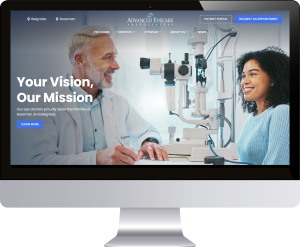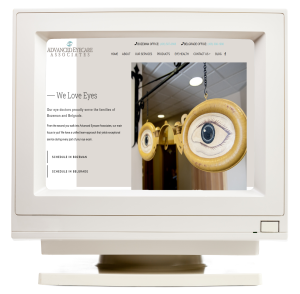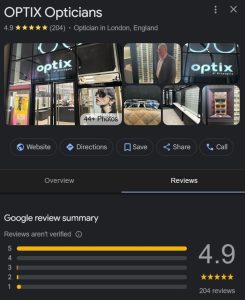Running an optical practice involves more than just clinical excellence. These days, if you want your business to grow, you also need to be visible online and appealing to prospective patients. Unfortunately, many practices aren’t aware of some basic optician marketing mistakes, which leads them to make errors that prevent them from attracting new customers.
The good news is that once you recognise these common optician marketing errors, you can review them and take the necessary steps to rectify them. Sometimes, this can be challenging, with access and set-up issues that can’t be resolved immediately, long waits to speak to customer support teams, or a limited understanding of navigating and optimising your platforms.
We commonly see this in many clients seeking our digital marketing services, and endeavour to become an extension of your team, taking the hard work off your hands with an experienced team of advertising, social media, website, and SEO (Search Engine Optimisation) marketing experts. With in-depth knowledge of the optical industry, we can quickly identify gaps and find the right solutions to implement on your behalf, and show you how to avoid marketing mistakes so you start seeing your desired results for online visibility and website traffic.
Our role, first and foremost, though, is to empower you with comprehensive guidance to take your online marketing to the next level. So, in this blog, we’ll highlight seven of the most common optician marketing mistakes, explain why they hurt your business, and offer straightforward tips to help prevent or remediate them.
1. Neglecting Your Google Business Profile
When someone searches for an optician in your area, your Google Business Profile is often the first thing they see. Yet the vast majority of practices leave this profile unclaimed, incomplete, or outdated.
According to BrightLocal, a platform specific to local SEO and online visibility, 87% of consumers used Google to evaluate local businesses. That means if your listing isn’t accurate and optimised, you’re losing out on potential patients.
How to avoid this mistake:
- Claim and verify your Google Business Profile
- Keep your business name, contact details, opening hours, and services up to date
- Add recent photos and reply to reviews as quickly as possible
- Post regular updates, such as promotions, practice news, events, or seasonal messages
2. Having a Poor Website Experience
Your website should work like your digital shopfront. People will simply click away if it’s slow, confusing, or not mobile-friendly. A poor user experience tells potential patients your practice is outdated or unreliable for current information on services, staff, and products.
How to avoid this mistake:
- Make sure your website is fast to load on all devices
- Use clear navigation with obvious calls to action like “Book an Appointment”
- Avoid pages of technical jargon and information – keep it easy to read
- Ensure your website design is optimised for mobiles and tablets
Advanced Eyecare Associates is an excellent example of a brochure website we developed for well-established multi-location optometrist practices in Montana, USA, that was only receiving about seven enquiries for eye exams every month

We created a brand new mobile-friendly design and optimised navigation so the menu was easy to understand and use, added clear calls to action to drive bookings to the client’s locations as per their primary objective for the website, and utilised on-page and technical SEO optimisations before it went live. This resulted in the client experiencing an almost immediate uplift in appointment enquiries and bookings – within the first few days of the site going live, they had already received eight appointment conversions – a statistic which has only improved since.
They are now averaging on 52 appointment requests per month since going live in July 2024. They also decided to take on our online listings manager digital marketing service, which means we can optimise any online listings from platforms to directories to make sure they are visible.
Thanks to this, the Bozeman location has seen a 893% uplift in backlink growth in the last year, meaning their website is visible across several different websites, while the Belgrade location has seen a 763% uplift in backlink growth.

On top of that, we are able to see that they have received 2.5k website visits and 4085 calls through the Boseman Google Business Profile in the last year, and 4226 calls and 2k website visits through the Belgrade Google Business Profile to the website in the last year, thanks to our optimisation efforts for these listings. The Listings Manager tool also provides benchmarking statistics which shows they are performing well above the industry average.
3. Overlooking the Power of Reviews
A common optician marketing mistake is underestimating how influential online reviews can be in building trust and credibility. Patients often check Google, Facebook, or Trustpilot before deciding where to book. If your practice has no reviews or just a few old ones, it can create doubt in the minds of prospective patients.
According to WiserNotify, a social-proof platform, a staggering 85% of users trust online reviews as much as personal recommendations.
How to avoid this mistake:
- Ask satisfied patients to leave a review before they leave your practice in person
- Have in-store displays with a QR code linking to your reviews platform
- Make it easy by sending a link via email or SMS shortly after their visit
- Respond diplomatically to all reviews, even the occasional negative one
- Respond within 48 hours to all reviews to show you are actively engaging with reviewers
- Highlight positive reviews on your website and social channels

4. Failing to Track What Works
Many practices spend money on digital marketing without truly knowing what results they’re getting. Whether it’s Google Ads, Facebook posts, or local directories, you might be wasting your budget if you’re not tracking performance.
How to avoid this mistake:
- Use tools like Google Analytics to track website visits and behaviour
- Set up unique landing pages for eye exams or other key services to monitor form submissions
- Install tracking pixels on your website to identify traffic or conversions that result directly from Google or social media advertising
- Install a pop-up on your website to track email subscriptions
- Check which marketing channels lead to real patient bookings
Understanding what works allows you to reinvest in what delivers results and cut what doesn’t. Our team works to produce tangible results for our clients through tracking, no matter what stage of the marketing funnel they are in. One important aspect to remember with tracking is always to have your target audience in mind to see if your marketing efforts reflect their needs.
In the awareness stage, we use content marketing, namely engaging and relevant social media posts, to educate target audiences and raise brand awareness around key services from eye exams to eyewear collections for men, women, and children, and specialist services like dry eye assessments or myopia management.
We track monthly performance using the platforms’ analytics, for example, Meta Business Suite or metrics from our scheduling platform, from follower counts to post reactions, shares, comments, link clicks and video views, as well as checking what types of content perform the best, i.e. static feed posts, reels, long or short captions, so we can see what resonates the most with your audiences to refine our content strategy.
During the consideration phase, we may use an email newsletter and SEO-rich blog which focuses on specific topics, for example, an eyewear brand spotlight or how a traditional eye exam compares to an advanced eye exam with an OCT or Optomap scan, with a call to action to request an appointment or contact your team for a complimentary frame styling consultation.
This is tracked using Google Analytics and our email platform metrics to see whether the targeted website pages are gaining the desired clicks and traffic from our campaigns. This helps us measure our success and consequently note any optimisations to improve traffic and ranking in the future.
When it comes to conversions, we typically use Google pay-per-click advertising to direct users to a specially designed landing page or email marketing to offer an incentive like a discount code for a product in-store or online to retarget your audience from the consideration phase.
Tracking form submissions from landing pages or using call tracking to see who contacted your practice to enquire about the service or product directly from our ads is key to measuring conversions for actions like requesting an appointment for an eye exam. Through email campaigns, we can also track how many purchases are made online as a direct result of sending the incentive to your customers if you have an online store.
Finally, for the retention part of the funnel, we will use Review Request software to make it easier to automate the post-conversion or purchase loyalty stage, where you want to retain your customers if they are satisfied with the services you have provided.
This enables you to invite customers to leave reviews across different search engines or directories, including Google and Bing, and respond to reviews all from one place for your convenience. This also facilitates easy tracking to see who has responded to your review requests and where they are leaving most of them, so you can see whether your retention strategy is working and focus your efforts on where you get the most traction.
5. Forgetting to Optimise for Local SEO
Even if you have a beautiful website, it won’t help much if it doesn’t appear in local search results. Local SEO (Search Engine Optimisation) is what helps you to show up when someone types “optician near me” or “eye test in [your town]”.
How to avoid this mistake:
- Include your location naturally in website copy, headings, meta titles and descriptions
- Create location-specific website service pages and Google Profile listings if you have multiple branches
- Make sure your practice is listed correctly in online directories like Yelp, Bing and Apple Maps
- Collect and respond to reviews, as they are a ranking factor for local search
- Write blog posts for your website using location-based keywords to target your local community
6. Inconsistent or Infrequent Social Media Posts
Having a social media profile is not enough. If your Facebook or Instagram profile has months-old posts, it may give the impression that your practice is inactive or disengaged with its current and potential followers.
How to avoid maketing mistakes:
- Post regularly with an 80% focus on awareness and education and 20% on sales or promotions. Your content can range from seasonal eyecare tips to behind-the-scenes footage or images of the practice, staff features, eyewear collection spotlights, events, charity/local community outreach, and patient testimonials.
- Use high-resolution visuals, such as practice photos and short-form reels, in the correct specs for your chosen platform to increase engagement and post reach.
- Keep an eye on any viral trends you see on social media and consider using them ad hoc if you think they work for your practice to add a ‘current’ and humorous feel to your posts which followers will instantly recognise and may react positively to.
- Don’t try to be on every platform — choose one or two that reflect your target audience and focus on those so you can post engaging content consistently.
- Avoid posting content just for the sake of it; try to focus on relevant information for your audiences that resonates with your practice identity and mission.
- Use accessible language to relate to your audience and build a strong connection with them—technical jargon alone will not engage them.
- Try to keep your tone conversational, upbeat, and light-hearted where appropriate to emulate authenticity and sincerity – be human and embrace the ‘independent’ spirit in a digital world of faceless businesses that simply want to make sales.
- Engage with your followers by replying to comments and direct messages within 24 hours of receiving them.
- Plan your content strategy at least a month ahead so you can schedule your posts to publish regularly in advance and consequently free up your time to focus on your patients without compromising your online presence.
- Assess your social media posts every month to see what is working well and what isn’t, and what times your followers are most engaged to help you refine your strategy for improved results.
- Trial and error is the best way to find what works for you, so don’t hesitate to try new strategies.
7. Relying on Word of Mouth Alone
Word of mouth is powerful, but it should not be your only strategy. Relying solely on referrals means your growth will be limited and unpredictable.
How to avoid this mistake:
- Combine traditional referrals with a modern digital presence
- Run occasional promotions or referral incentives
- Invest in local advertising to get in front of people who haven’t heard of you yet
- Marketing should be a steady engine for growth, not a hopeful wait for the phone to ring.
Final Thoughts
The digital world moves quickly, but that doesn’t mean you need to chase every trend. Instead, start by fixing the most common optician marketing mistakes and building a strong, local online presence. With just a few adjustments, you can create a reliable stream of new patients and set your practice apart from the competition.
Ready to Take the Next Step?
If you want help avoiding these pitfalls or creating a tailored marketing strategy for your practice, we’re here to help. OptiCommerce specialises in digital marketing for optical businesses, from Google Business optimisation to SEO and paid ads.
Book a free consultation with our team today and let’s talk about how we can help your practice grow.




